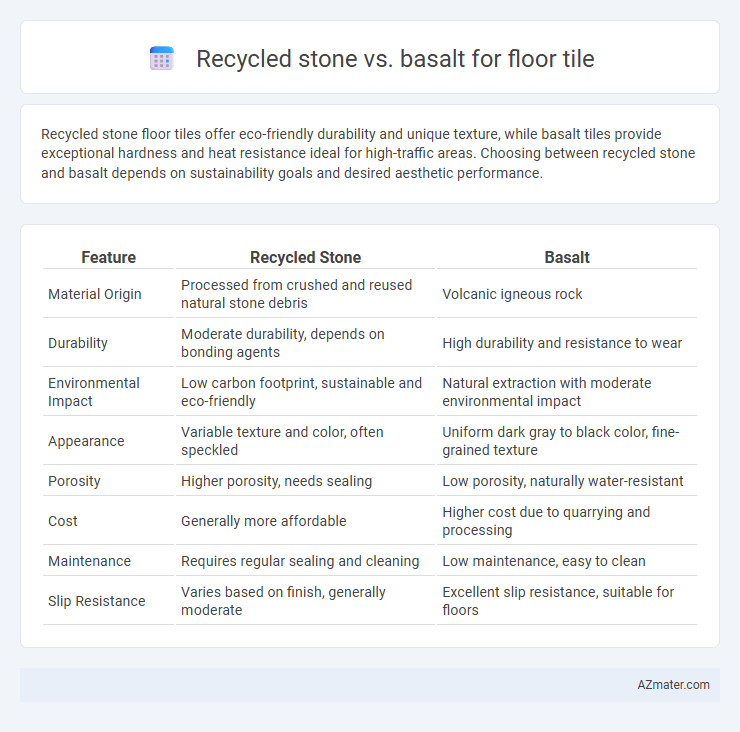Recycled stone floor tiles offer eco-friendly durability and unique texture, while basalt tiles provide exceptional hardness and heat resistance ideal for high-traffic areas. Choosing between recycled stone and basalt depends on sustainability goals and desired aesthetic performance.
Table of Comparison
| Feature | Recycled Stone | Basalt |
|---|---|---|
| Material Origin | Processed from crushed and reused natural stone debris | Volcanic igneous rock |
| Durability | Moderate durability, depends on bonding agents | High durability and resistance to wear |
| Environmental Impact | Low carbon footprint, sustainable and eco-friendly | Natural extraction with moderate environmental impact |
| Appearance | Variable texture and color, often speckled | Uniform dark gray to black color, fine-grained texture |
| Porosity | Higher porosity, needs sealing | Low porosity, naturally water-resistant |
| Cost | Generally more affordable | Higher cost due to quarrying and processing |
| Maintenance | Requires regular sealing and cleaning | Low maintenance, easy to clean |
| Slip Resistance | Varies based on finish, generally moderate | Excellent slip resistance, suitable for floors |
Introduction to Recycled Stone and Basalt Flooring
Recycled stone flooring utilizes repurposed materials such as crushed concrete, glass, and natural stone fragments, promoting sustainability and reducing environmental impact. Basalt flooring, derived from volcanic rock, offers exceptional durability, natural slip resistance, and a distinctive dark appearance favored in contemporary designs. Both materials provide eco-friendly and resilient options, with recycled stone emphasizing resource conservation and basalt highlighting natural strength and aesthetic appeal.
Material Composition and Sourcing
Recycled stone floor tiles are primarily composed of crushed concrete, glass, and other industrial byproducts, offering an eco-friendly alternative by repurposing waste materials from construction sites. Basalt tiles are naturally formed volcanic rock, known for their dense, durable composition sourced directly from quarries with minimal processing. The sustainable sourcing of recycled stone reduces landfill waste and lowers carbon emissions, whereas basalt requires energy-intensive extraction but provides consistent mineral quality and natural thermal properties.
Environmental Impact Comparison
Recycled stone floor tiles significantly reduce environmental impact by minimizing quarrying waste and lowering carbon emissions associated with raw material extraction compared to basalt tiles, which require intensive mining processes. Basalt tiles involve higher energy consumption due to quarrying and processing dense volcanic rock, increasing their overall carbon footprint. Utilizing recycled stone supports circular economy principles, conserving natural resources while reducing landfill contributions and energy usage in tile production.
Aesthetic Differences
Recycled stone floor tiles offer a unique and varied aesthetic, featuring irregular patterns and colors that reflect the history of repurposed materials, creating an eco-friendly yet stylish appearance. Basalt tiles provide a sleek, uniform look with a smooth texture and deep, rich black or gray tones, ideal for modern and minimalist designs. The choice between recycled stone and basalt significantly impacts the visual character of flooring, balancing rustic charm against contemporary elegance.
Durability and Strength
Recycled stone floor tiles offer moderate durability but may vary in strength depending on the source material and processing methods, often making them less consistent than basalt tiles. Basalt, a dense igneous rock, provides superior strength and exceptional resistance to wear, making it ideal for high-traffic areas and long-term use. Its natural hardness and low porosity contribute to enhanced durability and reduced maintenance compared to recycled stone alternatives.
Installation Process
Recycled stone tiles often require precise surface preparation and professional adhesive selection to ensure durability and proper adherence during installation, given their variable composition. Basalt floor tiles, known for their hardness and dense structure, demand specialized cutting tools and cautious handling to avoid chipping during installation. Both materials benefit from a skilled installer familiar with natural stone to achieve a seamless, long-lasting floor tile application.
Maintenance and Longevity
Recycled stone floor tiles offer easier maintenance due to their natural resistance to stains and scratches, requiring simple cleaning methods without specialized sealants. Basalt tiles, known for their dense, hard composition, provide exceptional longevity and durability, resisting wear and moisture over decades with minimal upkeep. Both materials contribute to eco-friendly flooring solutions, but basalt's superior hardness ensures a longer lifespan in high-traffic areas.
Cost Analysis
Recycled stone floor tiles typically offer a lower upfront cost compared to basalt, making them an economical choice for budget-conscious projects. Basalt tiles, known for their durability and longevity, may have higher installation and material costs but can provide better long-term value due to reduced maintenance and replacement expenses. Evaluating the total cost of ownership, including initial price, durability, and upkeep, is crucial when choosing between recycled stone and basalt for floor tiling.
Best Applications for Each Material
Recycled stone excels in eco-friendly flooring projects, offering sustainable durability ideal for residential patios, walkways, and low-traffic indoor areas where environmental impact is a priority. Basalt is best suited for high-traffic commercial spaces and exterior applications due to its exceptional hardness, weather resistance, and slip-resistant surface. The choice depends on balancing sustainability goals with performance needs, making recycled stone preferable for green building certifications and basalt optimal for heavy-duty, long-lasting flooring solutions.
Final Verdict: Choosing Between Recycled Stone and Basalt
Recycled stone tiles offer eco-friendly benefits and unique, varied textures that appeal to sustainable design projects, while basalt provides exceptional durability and a sleek, natural aesthetic ideal for high-traffic areas. Cost efficiency favors recycled stone for budget-conscious installations, whereas basalt's superior hardness and resistance to wear ensure long-term performance and value. The final choice depends on balancing environmental impact, design preferences, and functional requirements specific to the flooring application.

Infographic: Recycled stone vs Basalt for Floor tile
 azmater.com
azmater.com